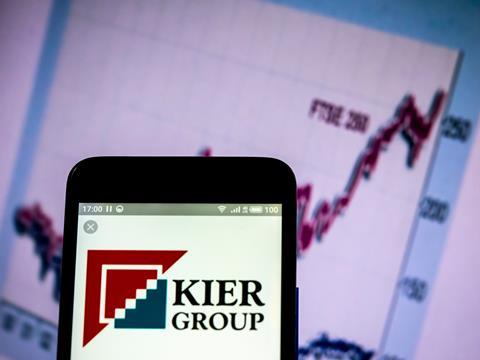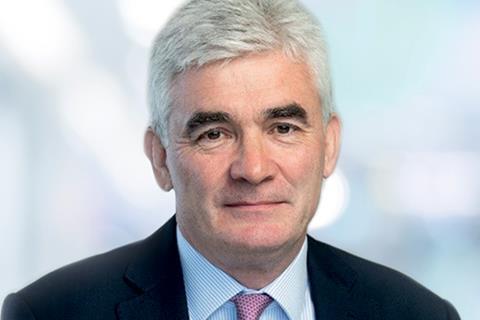The firm has a good long-term story to tell if only it could get its debt down and sell its housing business, writes Dave Rogers
Earlier this year, Kier brought forward its interim results announcement by two weeks. It seemed a fairly innocent move but if there was an attempt to avoid the glare of what was then the worsening impact of covid-19 鈥� its results were originally slated for 19 March which turned out to be four days before Boris Johnson put the country into lockdown 鈥� investors were left in no doubt about the damage the virus has caused the firm when it published a trading update last week.

That its underlying business seems in reasonable shape is not in doubt 鈥� though the history of the UK construction industry should always come with a warning marked: unexpected problem contract 鈥� with its 拢7bn-plus order book and the fact by far and away its biggest client is the government providing much comfort.
All good building blocks, for sure, but it is the here and the now that chief executive Andrew Davies (pictured below) is dealing with. Jam tomorrow takes a firm so far.
The two biggest headaches remain the same ones it has had for a while now: the firm鈥檚 eye-watering debt and getting rid of its housing business called Kier Living.
Davies put the housing arm up for sale 鈥� a move long expected by many as a way to raise fresh capital
Davies joined Kier on 15 April last year. A little less than four weeks earlier, Kier announced its half year results. It said average month-end net debt for the period, the six months to December 2018, was 拢430m. Last week, the firm warned the same figure for the year to June 2020, so 18 months later, was likely to be 拢440m 鈥� and that was after it had gone down to 拢395m for the six months to December 2019.
It put the blame on coronavirus, adding: 鈥淐ovid-19 has adversely affected the group鈥檚 revenue. The reduction in the group鈥檚 revenue due to covid-19 has resulted in a lower level of working capital inflow in the period than in the equivalent period in previous years.鈥�
>> Kier cuts more jobs on top of previously announced 1,200
>> Kier admits it might need to raise more money as debt goes up again
And it warned: 鈥淭he effects of covid-19 will continue to affect volumes and result in additional costs as the group adapts to operating in a post-covid-19 environment.鈥�
鈥淐ovid has been just the last thing needed in the industry as it was beginning to sniff improving trading,鈥� one source said. 鈥淐ovid has set them [Kier] 鈥� and the industry 鈥� back at least 12 months, possibly two years.鈥�
Sale of Kier Living gets bogged down
On 17 June, a few weeks after he joined, Davies put the housing arm up for sale 鈥� a move long expected by many as a way to raise fresh capital and enable the firm to concentrate on its core construction and infrastructure businesses.
The more optimistic analysts had been hoping for a sale by Christmas, certainly some news that the firm was in advanced talks with a preferred bidder. But Christmas came and went with the firm admitting at its interim results in March the process might take a lot longer than had been hoped. Despite this, Davies was adamant it would not be pushed to selling at any price. 鈥淚t鈥檚 a good business and we鈥檙e not going to be backed into corners and be a forced seller.鈥�

In March, investors were told the sale process could well drag on into next year. Last week there was no mention of how the sale was going 鈥� to be fair not many were expecting much of a timetable 鈥� and the only reference to the division was how Kier had reoroganised it 鈥渋nto a smaller, more disciplined organisation, with a focus on cash generation鈥�.
Some, though, are gloomy about how the whole process is really going. 鈥淸The sale of] Kier Living has become worse than bogged down,鈥� reckons one source.
鈥淢y sense is that the buyer they were moving to NDA with has gone cold due to the current environment and worries over the land bank values. I think there is a chance that it may not be a salvageable relationship. It is clear that Kier management have restructured this business again since Q1 which I think is on the view that it will have to start the whole process again in due course.鈥�
My sense is that the buyer they were moving to NDA with has gone cold due to the current environment
Market analyst
Some also think that by going public in revealing it might need to raise fresh equity, the money the sale of the housing arm was in part supposed to provide, is a bad move. 鈥淎 bombshell and madness,鈥� one says. 鈥淚t will simply undermine the share price until a refinancing is done. I simply do not understand why managements do this sort of thing.鈥�
Analyst Jonny Coubrough from Numis says: 鈥淲e have argued previously that until the balance sheet weakness is resolved 鈥� of which disposal of Living remains a key aspect 鈥� the share price will not attain a re-rating to reflect operational quality of business. Introducing the possibility of an equity raise, in part due to covid-19, adds another element of uncertainty to the investment case.鈥� Last week Kier鈥檚 share price closed 16% lower, at 78p, than it began the week.
Attracting overseas attention
There is, though, perhaps another reason for going public: to begin wooing would-be 鈥� possibly overseas 鈥� investors. Costain had similar criticism levelled at it when it went public with a cash-raising initiative in March. But it landed investment from Dubai contractor ASGC 鈥� not a household name in the Costain boardroom 鈥� with Costain confirming the firm, importantly, had approached it in the wake of its announcement. By going public, Costain had piqued interest. ASGC stumped up 拢25m and is now the firm鈥檚 largest shareholder with a 15% stake and Costain has raised the 拢100m it said it wanted to.
Cenkos analyst Kevin Cammack says Kier has a good story to tell but needs to start making inroads into its debt millstone: 鈥淭he latest update is quite positive in one sense but the market鈥檚 enthusiasm might wane when it notes the stubbornness of net debt to decline and the first hint that Kier may be looking to raise new equity.鈥�
He adds: 鈥淵ou can see why it is openly admitting that fresh equity might well be needed. It is expecting average month-end net debt to be c拢440m in the year, some 拢45m higher than the first half average and significantly higher than is optimal for the group.鈥� In other words, it is getting to be more and more of a problem the longer it stays at the sort of figure.
We see Kier as an attractive recovery proposition underpinned by a strong management team
Andrew Nussey, Peel Hunt
People are not panicking yet 鈥� the firm is well-placed for work with HS2, highways and education all set to be big revenue drivers in coming years. Analysts also like the news that its cost savings for its 2021 financial year are likely to be around 拢100m rather than originally envisaged 拢55m. Kier has said this increase has come from more job losses on top of the 1,200 already announced 鈥� at least 100 more 鈥� but adds other, unspecified savings have been found.
Peel Hunt鈥檚 Andrew Nussey says: 鈥淎lthough covid-19 has disrupted the anticipated pace of recovery and management鈥檚 strategic actions to reduce indebtedness we are encouraged by the underlying operational financial and strategic progress. We see Kier as an attractive recovery proposition underpinned by a strong management team.鈥�
Davies brings a tremendous amount of goodwill and gravitas. People want him to succeed in the turnaround but Cammack cautions clout will not be enough.
鈥淭he new management under the able Andrew Davies still has considerable challenges ahead over the next 12-18 months,鈥� he says. 鈥淚t will need more self-help, will need to improve operating cash flows and hopefully find an exit for Kier Living. It鈥檚 a long-haul recovery.鈥�























No comments yet